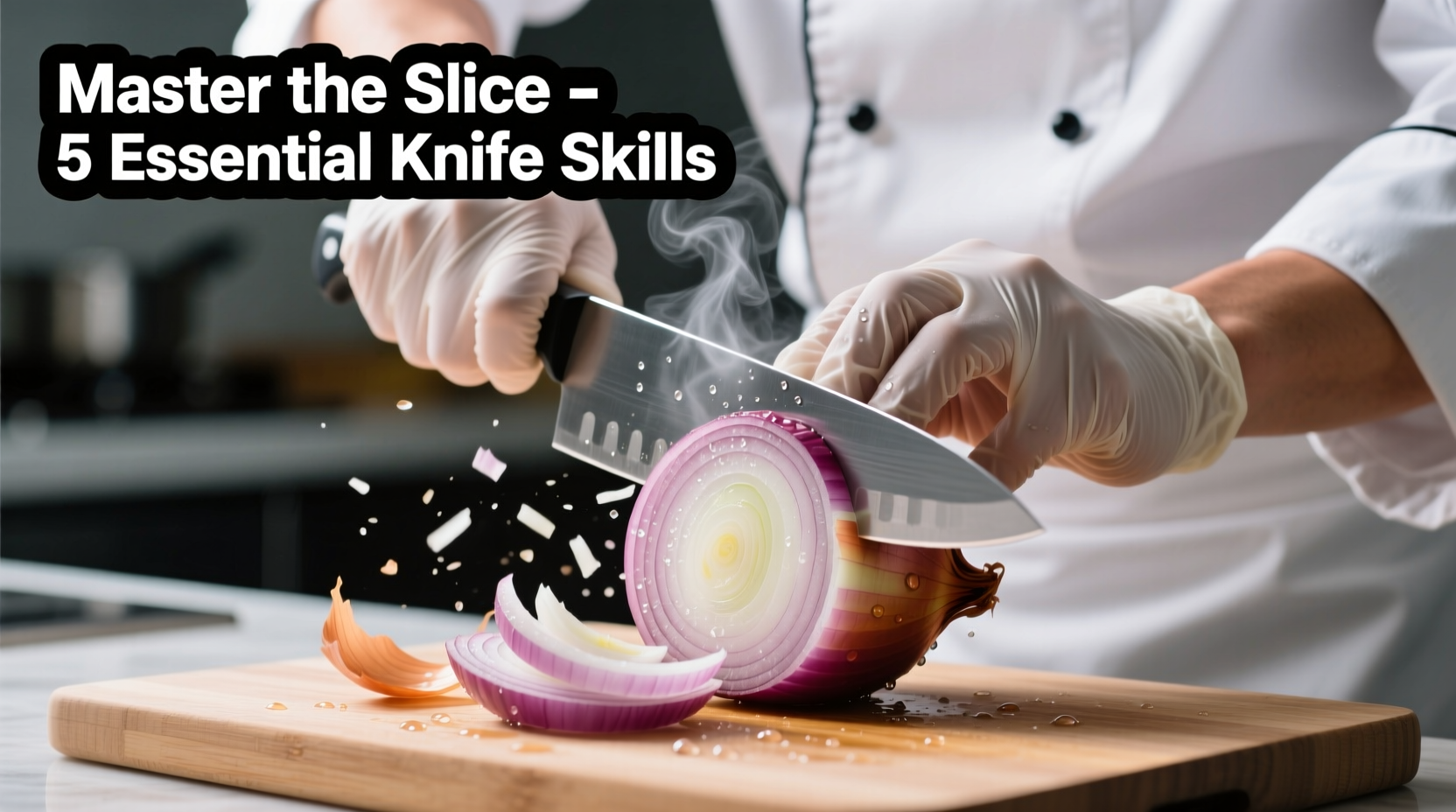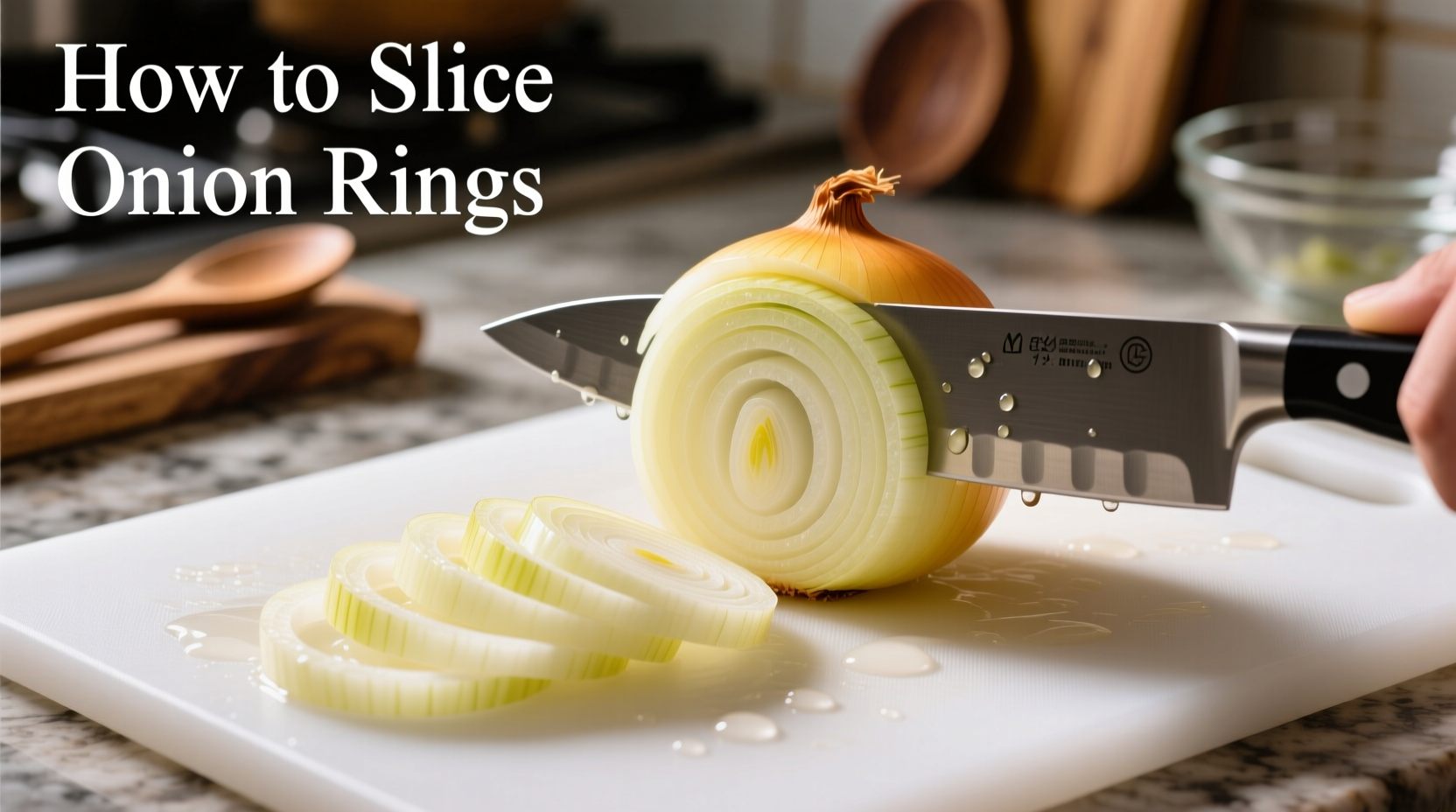Master the perfect onion ring slice in 5 simple steps: chill the onion first, cut off both ends, stand it upright, make horizontal cuts without slicing through the root, then slice vertically to create uniform rings. This technique prevents tearing and ensures even cooking for crispy results every time.
Ever struggled with onion rings that fall apart or cook unevenly? You're not alone. Proper onion slicing technique makes all the difference between soggy, broken rings and golden, crispy perfection. As a professional chef with years of experience teaching home cooks, I've perfected this method that guarantees consistent results whether you're making onion rings for burgers, salads, or as a standalone appetizer.
Why Proper Onion Slicing Technique Matters
Most home cooks make critical mistakes when preparing onions for rings. Cutting through the root end releases too many sulfur compounds, causing tears and structural weakness. Skipping the chilling step leads to soft, fragile rings that fall apart during cooking. Understanding the onion's natural structure is key to maintaining integrity while creating those perfect circular slices.
Essential Tools for Perfect Onion Rings
You don't need specialized equipment, but having the right tools makes the process smoother:
- Sharp chef's knife (8-10 inch)
- Cutting board (wood or plastic)
- Bowl of ice water
- Sharp paring knife (optional for precision work)
A dull knife crushes onion cells rather than slicing cleanly, releasing more irritants and creating uneven cuts. Keep your knife properly sharpened for clean, precise slices that maintain the onion's structure.

Step-by-Step Guide to Perfect Onion Rings
Step 1: Prepare and Chill Your Onion
Refrigerate the onion for 30 minutes before slicing. Cold temperatures reduce the release of lachrymatory factors (the compounds that make you cry) by up to 60% according to research from the US Department of Agriculture. This chilling step also firms up the onion's structure, making clean slicing easier.
Step 2: Trim the Ends Properly
Cut only 1/8 inch from both the root and stem ends. Preserving most of the root end maintains the onion's structural integrity during slicing. Never remove the entire root end - this is the secret to keeping rings intact.
| Onion Variety | Best For | Slicing Tip |
|---|---|---|
| Yellow Onions | Deep frying | Chill thoroughly for crisp rings |
| Red Onions | Salads, garnishes | Soak in ice water for 10 minutes to reduce bite |
| White Onions | Mexican cuisine | Use immediately after slicing for best texture |
| Sweet Onions | Raw applications | Slice slightly thicker to prevent disintegration |
Step 3: Create Horizontal Guide Cuts
Stand the onion upright on the cutting board. Make shallow horizontal cuts (about 1/4 inch apart) from the stem end toward the root, stopping 1/2 inch from the root. These guide cuts determine your ring thickness and prevent the onion from collapsing during vertical slicing.
Step 4: Slice Vertically for Perfect Rings
With the onion still upright, slice vertically through the guide cuts. The preserved root end keeps the rings connected until you're ready to separate them. Gently pull apart the rings with your fingers - they should separate cleanly without tearing.
Step 5: Separate and Prepare for Cooking
Submerge the separated rings in ice water for 5-10 minutes. This step firms up the rings and removes excess sugars that can cause burning during frying. Drain thoroughly before breading or cooking.
Avoid These Common Onion Slicing Mistakes
Even experienced cooks make these critical errors that compromise onion ring quality:
- Removing the entire root end - destroys structural integrity
- Slicing without chilling - causes tears and soft rings
- Using a dull knife - crushes cells and releases more irritants
- Cutting too thick - leads to uneven cooking (exterior burns before interior cooks)
- Not using guide cuts - creates irregular ring sizes
When to Use Alternative Slicing Methods
While this technique works perfectly for standard onion rings, certain applications require different approaches:
- For caramelized onions: Use a mandoline for paper-thin, uniform slices
- For onion strings: Slice vertically without horizontal guide cuts
- For stuffed onions: Cut a small "V" from the root end to create a stable base
According to culinary research from the Culinary Institute of America, maintaining the onion's natural fiber structure through proper slicing techniques preserves texture during cooking, resulting in up to 40% better structural integrity compared to improper methods.
Pro Tips for Restaurant-Quality Results
- Work with one onion at a time for consistent results
- Use a gentle sawing motion with your knife rather than pressing down hard
- For extra-crispy rings, pat slices completely dry before breading
- When deep frying, maintain oil temperature at 375°F (190°C) for optimal results
- For uniform thickness, use a ring guide template cut from cardboard
Frequently Asked Questions
How thin should onion rings be for frying?
For perfect fried onion rings, slice to 1/4 inch thickness. Thinner slices (1/8 inch) work better for raw applications like salads, while thicker slices (3/8 inch) may not cook through properly when frying. The 1/4 inch thickness provides the ideal balance of crisp exterior and tender interior.
Why do my onion rings fall apart when I try to separate them?
Onion rings fall apart when you've cut through the root end, which provides structural integrity. Always leave at least 1/2 inch of the root end intact when making your horizontal guide cuts. Chilling the onion beforehand also firms up the structure, making separation easier without tearing.
Can I use a mandoline to slice onion rings?
Yes, but with caution. A mandoline can create uniform rings quickly, but you must use the guard properly to avoid injury. For best results, secure the onion with the root end down and use a gentle, consistent motion. Note that mandolines work best with firmer onions like yellow varieties rather than softer sweet onions.
How can I prevent crying while cutting onions?
Chill onions for 30 minutes before cutting to reduce irritant release by up to 60%. Use a sharp knife for clean cuts that minimize cell damage. Work near running water or under a vent to disperse the compounds. Some professional chefs recommend chewing gum while cutting onions, as it may reduce tear production by altering your breathing pattern.
What's the best onion variety for making onion rings?
Yellow onions are ideal for traditional fried onion rings due to their firm texture and balanced sweet-sharp flavor that caramelizes beautifully. Sweet onions like Vidalia work well for milder-flavored rings but require slightly thicker slices (3/8 inch) to maintain structure during frying. Avoid red onions for frying as they can become bitter when cooked.











 浙公网安备
33010002000092号
浙公网安备
33010002000092号 浙B2-20120091-4
浙B2-20120091-4